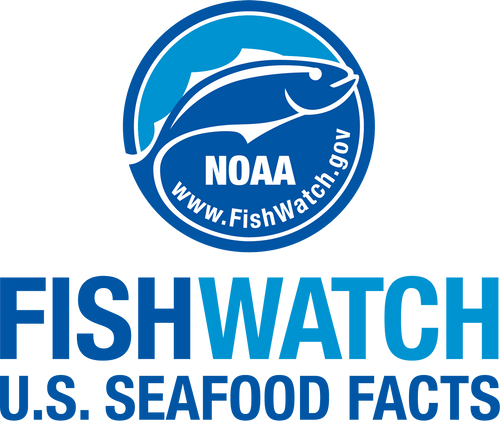About the Species
U.S. wild-caught Pacific skipjack tuna is a smart seafood choice because it is sustainably managed and responsibly harvested under U.S. regulations.

Population
The stocks are not overfished.

Fishing Rate
Not subject to overfishing.

Habitat Impact
Fishing gear used to catch skipjack tuna rarely contacts the ocean floor so habitat impacts are minimal.

Bycatch
Regulations are in place to minimize bycatch.
Population Status
- There are two stocks of skipjack tuna: the Eastern Pacific stock and the Western and Central Pacific stock. According to the most recent stock assessments:
- The Eastern Pacific stock is not overfished and not subject to overfishing (2004 stock assessment). Summary stock assessment information can be found on Stock SMART.
- The Western and Central Pacific stock is not overfished and is not subject to overfishing (2019 stock assessment). Summary stock assessment information can be found on Stock SMART.
- Skipjack tuna is a notoriously difficult species to assess. Due to skipjack’s high and variable productivity, it’s difficult to determine the effect of fishing on the population using standard fisheries data and stock assessment methods. Assessments are particularly difficult for the Eastern Tropical Pacific stock due to limited data.
Appearance
- Skipjack tuna do not have scales except on the corselet and the lateral line. The corselet is a band of large, thick scales forming a circle around the body behind the head and extending backward along the lateral line. The lateral line is a faint line running lengthwise down each side of the fish.
- Their back is dark purplish-blue, and their lower sides and belly are silvery with four to six conspicuous dark bands that run from behind the head to the tail, which may look like a series of dark blotches.
Biology
- Like other tropical tunas, skipjack tuna grow fast, up to nearly 4 feet and more than 70 pounds.
- They have a short life span compared to other temperate tunas, around 8 to 12 years.
- In the Pacific, skipjack are able to reproduce when they reach about 1.3 feet in length.
- They spawn throughout the year in tropical waters and seasonally (spring to early fall) in subtropical waters.
- Depending on their size, females produce between 100,000 and 2 million eggs each time they spawn.
- Once fertilized, the eggs hatch in about 1 day, depending on temperature.
- Skipjack spawn more than once a season, and some spawn almost every day.
- They are opportunistic feeders, preying on a variety of fish, crustaceans, cephalopods, mollusks, and sometimes other skipjack tunas.
- Large pelagic fishes such as billfish, sharks, and other large tunas prey on skipjack tuna.
Where They Live
Range
- Skipjack tuna are found in tropical and subtropical oceans around the world, including the waters around the U.S. Pacific Islands and the U.S. West Coast.
Habitat
- Skipjack tuna is a highly migratory species, swimming long distances to feed and reproduce.
- They are a pelagic species—they mostly live in the open ocean, although they may spend part of their life in nearshore waters.
- They can be found in large schools swimming in warm, well-mixed surface waters and to depths of 850 feet during the day.
- They generally stay near the surface at night.
Fishery Management
- NOAA Fisheries and the Pacific Fishery Management Council manage this fishery on the West Coast.
- Managed under the Fishery Management Plan for U.S. West Coast Fisheries for Highly Migratory Species:
- Fishermen must have a permit to harvest tuna and must keep logbooks documenting their catch.
- Gear restrictions are in place to minimize bycatch.
- Large purse seine vessels that fish for tuna in the eastern Pacific Ocean are required to have 100 percent observer coverage.
- All other purse seine vessels must carry a fishery observer, if requested by NOAA Fisheries.
- NOAA Fisheries and Western Pacific Fishery Management Council manage this fishery in the Pacific Islands.
- Managed under the Fishery Ecosystem Plan for the Pelagic Fisheries of the Western Pacific:
- Fishermen must have a permit to harvest tuna and must keep logbooks documenting their catch.
- Gear restrictions and operational requirements minimize bycatch.
- A limit on the number of permits for Hawaii and American Samoa longline fisheries controls participation in the fishery.
- Management of highly migratory species, like Pacific skipjack tuna, is complicated because the species migrate thousands of miles across international boundaries and are fished by many nations.
- Effective conservation and management of this resource requires international cooperation as well as strong domestic management.
- Two international organizations, Inter-American Tropical Tuna Commission (IATTC) and the Western and Central Pacific Fisheries Commission (WCPFC), manage this fishery internationally. Working with the U.S. Department of State, NOAA Fisheries domestically implements the IATTC and WCPFC conservation and management measures.
- The United States has implemented conservation and management measures adopted by the IATTC to control effort in the tuna purse seine fishery and reduce impacts to other species such as sea turtles, sharks, seabirds, and juvenile tunas.
- Time/area closures to reduce the catch of juvenile tunas.
- Required retention of tuna caught in the purse seine fishery.
- The United States has also implemented conservation and management measures adopted by the WCPFC to control juvenile tuna catch in the purse seine fishery targeting skipjack and to minimize impacts to non-target species such as sea turtles and sharks.
- Limits on the number of days purse seiners can spend fishing in certain areas.
- A seasonal prohibition on the use of fish aggregating devices by purse seine vessels.
- Closure of specific high seas areas in the Western and Central Pacific to purse seine vessels.
- A requirement for purse seine vessels to retain certain tuna species.
- Purse seiners fishing in the WCPFC’s management area must also carry a fishery observer and must follow specific handling requirements in case they accidentally catch a sea turtle.
- Under the South Pacific Tuna Treaty, U.S. purse seine vessels operating throughout the Western and Central Pacific Ocean must be registered and are monitored through logbooks, cannery landing receipts, national surveillance activities, observers, and port sampling.
- Purse seiners in the Eastern Pacific also operate under the International Dolphin Conservation Program, a multilateral agreement aimed at reducing and minimizing bycatch of dolphins and undersize tuna.
- In 2000, the United States established the Dolphin-Safe Tuna Tracking and Verification Program to monitor the domestic production and importation of all frozen and processed tuna products nationwide and to authenticate any associated dolphin-safe claim.
Harvest
- Commercial fishery:
- Most of the global harvest of Pacific skipjack tuna comes from the Western and Central Pacific Ocean (WCPO).
- U.S. fisheries typically account for less than 10 percent of harvest from the WCPO.
- In 2022, commercial landings of Pacific skipjack tuna totaled 300,000 pounds and were valued at $860,000, according to the NOAA Fisheries commercial fishing landings database (these landings do not include skipjack tuna landed outside the U.S.).
- The majority of landings of non-purse seine caught skipjack tuna are in Hawaii, with some landings in American Samoa, the Commonwealth of the Northern Mariana Islands, and Guam.
- Gear types, habitat impacts, and bycatch:
- Purse seines are primarily used to catch Pacific skipjack tuna.
- Skipjack tuna is also caught in longline, pole-and-line, and troll fisheries.
- Fishing gear used to catch Pacific skipjack tuna rarely contacts the seafloor so habitat impacts are minimal.
- Interactions with protected species such as sea turtles, marine mammals, and seabirds in these fisheries are rare and survival rates are estimated to be high for all gear types.
- Many purse seine fishermen use fish aggregating devices (FADs) to target tunas.
- FADs can be drifting, floating or submerged objects deployed and tracked by vessels, including through the use of radio or satellite buoys, for the purpose of aggregating target tuna species.
- FADs are also known to attract non-target and bycatch species, including juvenile tunas, sharks, other fish, and occasionally protected species.
- Use of FADS is prohibited in certain areas at certain times of the year to regulate fishing effort and reduce bycatch of juvenile tunas.
- Longline and purse seine fishermen are trained in safe handling and release techniques for sea turtles, seabirds, and marine mammals, and they carry and use specific equipment for handling and releasing these animals.
- Scientists and managers continue to monitor bycatch in these fisheries through logbooks and fishery observer programs.
- Recreational fishery:
- Recreational anglers fish for skipjack tuna with troll, rod-and-reel, and handline gear and sometimes by free-diving with spear guns.
- Off California, anglers must be licensed and must follow daily bag limits. Recreational charter boats must keep logbooks of their catch.
- There are no federal regulations for recreational fishing off Hawaii and U.S. Pacific Island territories, but local rules may apply.
- In 2021, recreational anglers landed 1.1 million pounds of skipjack tuna, according to the NOAA Fisheries recreational fishing landings database. These figures may not match other agency sources of data due to confidential information.
Scientific Classification
- Skipjack tuna are found in tropical and subtropical oceans around the world, including the waters around the U.S. Pacific Islands and the U.S. West Coast.
- Skipjack tuna is a highly migratory species, swimming long distances to feed and reproduce.
- They are a pelagic species—they mostly live in the open ocean, although they may spend part of their life in nearshore waters.
- They can be found in large schools swimming in warm, well-mixed surface waters and to depths of 850 feet during the day.
- They generally stay near the surface at night.
Fishery Management
- NOAA Fisheries and the Pacific Fishery Management Council manage this fishery on the West Coast.
- Managed under the Fishery Management Plan for U.S. West Coast Fisheries for Highly Migratory Species:
- Fishermen must have a permit to harvest tuna and must keep logbooks documenting their catch.
- Gear restrictions are in place to minimize bycatch.
- Large purse seine vessels that fish for tuna in the eastern Pacific Ocean are required to have 100 percent observer coverage.
- All other purse seine vessels must carry a fishery observer, if requested by NOAA Fisheries.
- NOAA Fisheries and Western Pacific Fishery Management Council manage this fishery in the Pacific Islands.
- Managed under the Fishery Ecosystem Plan for the Pelagic Fisheries of the Western Pacific:
- Fishermen must have a permit to harvest tuna and must keep logbooks documenting their catch.
- Gear restrictions and operational requirements minimize bycatch.
- A limit on the number of permits for Hawaii and American Samoa longline fisheries controls participation in the fishery.
- Management of highly migratory species, like Pacific skipjack tuna, is complicated because the species migrate thousands of miles across international boundaries and are fished by many nations.
- Effective conservation and management of this resource requires international cooperation as well as strong domestic management.
- Two international organizations, Inter-American Tropical Tuna Commission (IATTC) and the Western and Central Pacific Fisheries Commission (WCPFC), manage this fishery internationally. Working with the U.S. Department of State, NOAA Fisheries domestically implements the IATTC and WCPFC conservation and management measures.
- The United States has implemented conservation and management measures adopted by the IATTC to control effort in the tuna purse seine fishery and reduce impacts to other species such as sea turtles, sharks, seabirds, and juvenile tunas.
- Time/area closures to reduce the catch of juvenile tunas.
- Required retention of tuna caught in the purse seine fishery.
- The United States has also implemented conservation and management measures adopted by the WCPFC to control juvenile tuna catch in the purse seine fishery targeting skipjack and to minimize impacts to non-target species such as sea turtles and sharks.
- Limits on the number of days purse seiners can spend fishing in certain areas.
- A seasonal prohibition on the use of fish aggregating devices by purse seine vessels.
- Closure of specific high seas areas in the Western and Central Pacific to purse seine vessels.
- A requirement for purse seine vessels to retain certain tuna species.
- Purse seiners fishing in the WCPFC’s management area must also carry a fishery observer and must follow specific handling requirements in case they accidentally catch a sea turtle.
- Under the South Pacific Tuna Treaty, U.S. purse seine vessels operating throughout the Western and Central Pacific Ocean must be registered and are monitored through logbooks, cannery landing receipts, national surveillance activities, observers, and port sampling.
- Purse seiners in the Eastern Pacific also operate under the International Dolphin Conservation Program, a multilateral agreement aimed at reducing and minimizing bycatch of dolphins and undersize tuna.
- In 2000, the United States established the Dolphin-Safe Tuna Tracking and Verification Program to monitor the domestic production and importation of all frozen and processed tuna products nationwide and to authenticate any associated dolphin-safe claim.
Harvest
- Commercial fishery:
- Most of the global harvest of Pacific skipjack tuna comes from the Western and Central Pacific Ocean (WCPO).
- U.S. fisheries typically account for less than 10 percent of harvest from the WCPO.
- In 2022, commercial landings of Pacific skipjack tuna totaled 300,000 pounds and were valued at $860,000, according to the NOAA Fisheries commercial fishing landings database (these landings do not include skipjack tuna landed outside the U.S.).
- The majority of landings of non-purse seine caught skipjack tuna are in Hawaii, with some landings in American Samoa, the Commonwealth of the Northern Mariana Islands, and Guam.
- Gear types, habitat impacts, and bycatch:
- Purse seines are primarily used to catch Pacific skipjack tuna.
- Skipjack tuna is also caught in longline, pole-and-line, and troll fisheries.
- Fishing gear used to catch Pacific skipjack tuna rarely contacts the seafloor so habitat impacts are minimal.
- Interactions with protected species such as sea turtles, marine mammals, and seabirds in these fisheries are rare and survival rates are estimated to be high for all gear types.
- Many purse seine fishermen use fish aggregating devices (FADs) to target tunas.
- FADs can be drifting, floating or submerged objects deployed and tracked by vessels, including through the use of radio or satellite buoys, for the purpose of aggregating target tuna species.
- FADs are also known to attract non-target and bycatch species, including juvenile tunas, sharks, other fish, and occasionally protected species.
- Use of FADS is prohibited in certain areas at certain times of the year to regulate fishing effort and reduce bycatch of juvenile tunas.
- Longline and purse seine fishermen are trained in safe handling and release techniques for sea turtles, seabirds, and marine mammals, and they carry and use specific equipment for handling and releasing these animals.
- Scientists and managers continue to monitor bycatch in these fisheries through logbooks and fishery observer programs.
- Recreational fishery:
- Recreational anglers fish for skipjack tuna with troll, rod-and-reel, and handline gear and sometimes by free-diving with spear guns.
- Off California, anglers must be licensed and must follow daily bag limits. Recreational charter boats must keep logbooks of their catch.
- There are no federal regulations for recreational fishing off Hawaii and U.S. Pacific Island territories, but local rules may apply.
- In 2021, recreational anglers landed 1.1 million pounds of skipjack tuna, according to the NOAA Fisheries recreational fishing landings database. These figures may not match other agency sources of data due to confidential information.
- Recreational anglers fish for skipjack tuna with troll, rod-and-reel, and handline gear and sometimes by free-diving with spear guns.
Scientific Classification
| Kingdom | Animalia | Phylum | Chordata | Class | Actinopterygii | Order | Scombriformes | Family | Scombridae | Genus | Katsuwonus | Species | pelamis |
|---|
Last updated by NOAA Fisheries on 09/06/2024
Featured News
 The 20th Annual Western and Central Pacific Fisheries Commission meeting at the Te Are Kariori (National Auditorium) in
Rarotonga, Cook Islands. Credit: NOAA Fisheries.
The 20th Annual Western and Central Pacific Fisheries Commission meeting at the Te Are Kariori (National Auditorium) in
Rarotonga, Cook Islands. Credit: NOAA Fisheries.
 Fifteen of the 83 species included in the Pacific Islands vulnerability assessment. From left to right: Acanthurus achilles, Caranx melampygus, Tripneustes gratilla, Acanthurus triostegus, Scarus rubroviolaceus, Cephalopholis argus, Octopus cyanea, Lutjanus kasmira, Panulirus penicillatus, Triaenodon obesus, Selar crumenophthalmus, Ctenochaetus strigosus, Naso unicornis, Zebrasoma flavescens, Tridacna maxima. Photo credit: Bruce Mundy.
Fifteen of the 83 species included in the Pacific Islands vulnerability assessment. From left to right: Acanthurus achilles, Caranx melampygus, Tripneustes gratilla, Acanthurus triostegus, Scarus rubroviolaceus, Cephalopholis argus, Octopus cyanea, Lutjanus kasmira, Panulirus penicillatus, Triaenodon obesus, Selar crumenophthalmus, Ctenochaetus strigosus, Naso unicornis, Zebrasoma flavescens, Tridacna maxima. Photo credit: Bruce Mundy.
 The IATTC adopted new three-year management measures for tropical tunas including yellowfin caught by purse seine and longline vessels in the eastern Pacific Ocean.
Credit: Shutterstock/Al McGlashan
The IATTC adopted new three-year management measures for tropical tunas including yellowfin caught by purse seine and longline vessels in the eastern Pacific Ocean.
Credit: Shutterstock/Al McGlashan
 Grilled tuna lemon with mayo. Credit: North Carolina Sea Grant/Vanda Lewis.
Grilled tuna lemon with mayo. Credit: North Carolina Sea Grant/Vanda Lewis.
Seafood Facts

Is Pacific Skipjack Tuna Sustainable?
U.S. wild-caught Pacific skipjack tuna is a smart seafood choice because it is sustainably managed and responsibly harvested under U.S. regulations.
Availability
Year-round.
Source
U.S. wild-caught from Hawaii, California, U.S. Pacific Island territories, and the high seas.
Taste
Skipjack tuna has the most pronounced taste of all of the tropical tunas.
Texture
Firm and moist, with large flakes.
Color
When raw, good-quality skipjack tuna meat is deep red. Smaller fish are lighter red. Cooked skipjack becomes light gray.
Health Benefits
Skipjack is an excellent source of low-fat protein.
Nutrition Facts
Servings: 1; Serving Weight: 100 g (raw); Calories: 103; Protein: 22.00 g; Total Fat: 1.01 g; Total Saturated Fatty Acids: 0.328 g; Carbohydrate: 0 g; Total Sugars: 0 g; Total Dietary Fiber: 0 g; Cholesterol: 47 mg; Selenium: 36.5 mcg; Sodium: 37 mgMore Information
Last updated by NOAA Fisheries on 09/06/2024
Seafood News
 A signboard thanking patrons at Tuna Harbor Dockside Market in San Diego. Credit: Tuna Harbor Dockside Market.
A signboard thanking patrons at Tuna Harbor Dockside Market in San Diego. Credit: Tuna Harbor Dockside Market.
 Credit: NOAA Fisheries/Brianna Shaughnessy
Credit: NOAA Fisheries/Brianna Shaughnessy
 An oyster reef with lush greenery in the background. Credit: Adobe Stock
An oyster reef with lush greenery in the background. Credit: Adobe Stock
Data & Maps
American Samoa Longline Logbook Reports 2022
Logbook summary reports for the 2022 calendar year.
Hawaii and California Longline Logbook Reports 2022
Logbook summary reports for the 2022 calendar year.
Hawaii and California Longline Logbook Reports 2021
Logbook summary reports for the 2021 calendar year.
American Samoa Longline Logbook Reports 2021
Logbook summary reports for the 2021 calendar year.
Research
Relative Impacts of Simultaneous Stressors on a Pelagic Marine Ecosystem
Model suggests that due to climate change, a decline in the yield of Hawaii's longline fishery may…
Last updated by NOAA Fisheries on 09/06/2024




